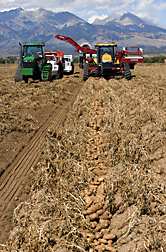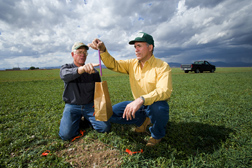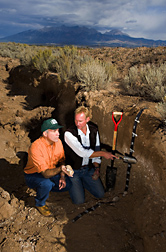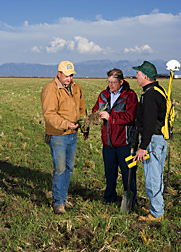Healthy Potatoes, Healthy People, Healthy Profit
Improving Conservation in the Potato Field
The popularity of carbohydrates fluctuates with fickle diet trends. But even so, potatoes are never far from the nation’s table. An energizing source of complex carbohydrates, vitamins, and minerals, the potato is America’s favorite vegetable. We eat about 140 pounds per person each year, according to USDA’s Economic Research Service. To ensure that we don’t meet our demand for potatoes at the expense of the environment, ARS scientists are studying which potato management practices can improve soil conservation and groundwater quality.
Going Under Cover
Heavily fertilized crops with shallow roots, such as potatoes—grown on irrigated, coarse-textured soils—are susceptible to nitrate leaching. But, says Jorge Delgado, a soil scientist at ARS’s Soil Plant Nutrient Research Unit in Fort Collins, Colorado, “nitrogen recovery can be significantly improved, and nitrate leaching minimized, by following a shallow-rooted crop with a deep-rooted cover crop, like winter rye, malting barley, or winter wheat.”
Cover crops have many benefits. They can reduce wind erosion and protect groundwater by recovering nitrate from soil and irrigation water. Deep-rooted cover crops sequester carbon, cycle nutrients, and draw nitrate from far down in the soil. Some covers, like winter rye and wheat, can even be used for grazing.
Delgado says that in a cooperative study with USDA’s Natural Resources Conservation Service (NRCS), an early-planted winter rye cover crop increased subsequent tuber yield by an average of 1,500 pounds per acre. And in work with NRCS and Colorado State University, when potatoes followed a sorghum cover crop instead of fallow, total marketable yield increased 12 percent—and tubers were larger. The results show that farmers can generate income of $60 to $100 more per acre by using cover crops.
|
|
Nitrogen Analysis and Precision Conservation
The researchers are also experimenting with cutting-edge technology. Using innovations like geographic information systems (GIS), global positioning systems, modeling, and remote sensing, the Fort Collins scientists evaluate various farming practices to see which ones use nitrogen most efficiently.
Management practices that incorporate elements of conservation and precision agriculture are referred to as “precision conservation.” The scientists “have developed several important tools to help gauge nitrogen management, like a new version of the Nitrogen Leaching and Environmental Analysis Package, a computer model which uses GIS technology,” says research leader Ronald Follett.
With precision-conservation techniques and GIS databases, scientists identify areas susceptible to nitrate leaching losses. “With proper timing and placement of nitrogen fertilizer and rotations that include deeper rooted, high-biomass-producing crops, we can increase nitrogen-use efficiency and conserve water quality,” Delgado says.
Bring On the Brassicas
The Pacific Northwest accounts for more than half of America’s $3 billion potato crop, with Washington and Idaho as the nation’s top producers. Nitrate leaching and erosion also affect eastern Washington’s Columbia Basin, where soils are typically low in organic matter. Some potato growers replenish the soil’s organic matter and stave off erosion and nitrate losses by planting fall cover crops of mustard and other Brassica species. In Washington State alone, use of Brassica cover crops in irrigated potato rotations has grown from 400 acres to more than 20,000 in a few years.
At the Vegetable and Forage Crops Production Research Unit in Prosser, Washington, microbiologist Hal Collins has been conducting field studies to determine how much nitrogen these cover crops release into soil as they decompose and their effects on microbe and nematode populations, especially those considered potato pests. As soil microbes break down plant material, they release nitrogen in the Brassica plants and make it available to the next crop. This process is known as “nitrogen mineralization.”
Collins combined his field-research expertise with the analytical know-how of Delgado’s group. Using isotopic nitrogen (15N) and a field plot, the scientists measured the amount of nitrogen contributed by mineralization of Brassica cover crops in the soil. The isotope allows them to track how much nitrogen is absorbed by the following potato crop from decomposition of the Brassica.
They found that 29 percent of the nitrogen once contained in the aboveground parts of the Brassica crop was recovered in the subsequent potato crop. This recycling process is called “green cover-crop fertilization.” Collins and Delgado measured a green-fertilization effect equal to 27 to 39 pounds of nitrogen per acre that will be taken up by the potato crop. With 20,000 acres planted in Brassica cover crops, this effect increases nitrogen-use efficiency and decreases nitrogen losses across the region. Collins estimates that the cover crop could save growers $15 to $20 per acre at current fertilizer prices.
“The implication of this work will be to fine-tune nitrogen-management recommendations in a potato rotation system, including the cover crops,” says research leader Ashok Alva.
Nitrogen Use Studies
In Maine, farmers have been planting and digging up potatoes for nearly 150 years, but ARS researchers say there’s plenty to learn about sustainable potato production—including nitrogen management.
“We’ve known for a while that rotations are one way to add nutrients to the soil,” says ARS agronomist Tim Griffin, of the New England Plant, Soil, and Water Laboratory in Orono, Maine. “Crops that fix, or make, their own nitrogen—like clover, alfalfa, and soybeans—can start releasing organic nitrogen once they’re plowed under.”
Maine researchers are looking across the entire potato system for answers to nitrogen-use questions, like how do you know if more nitrogen is being released in the soil than a crop can use? The scientists are studying obvious influences—soil organic matter content, crop sequences, disease presence, and water availability—as well as more subtle factors, like soil temperature.
|
|
Griffin says higher temperatures increase microbial activity, creating more available nitrogen for the crops. The researchers have modeled the influence of temperature on decomposition and nitrogen availability to predict the best time to apply additional fertilizer to meet the crop’s needs. “This means less nitrate will be lost to groundwater,” says research leader Wayne Honeycutt.
One of the toughest factors to account for is weather. In Maine, most potato farms rely on the fickle precipitation that nature provides. “We are interested in the interaction of plant growth and nitrogen supply when irrigation is used,” says Griffin.—By Laura McGinnis, Jan Suszkiw, and Erin K. Peabody, Agricultural Research Service Information Staff.
This research is part of Soil Resource Management, an ARS National Program (#202) described on the World Wide Web at www.nps.ars.usda.gov.
To reach scientists mentioned in this article, contact Laura McGinnis, USDA-ARS Information Staff, 5601 Sunnyside Ave., Beltsville, MD 20705; phone (301) 504-1654, fax (301) 504-1486.
"Healthy Potatoes, Healthy People, Healthy Profit" was published in the May 2006 issue of Agricultural Research magazine.












